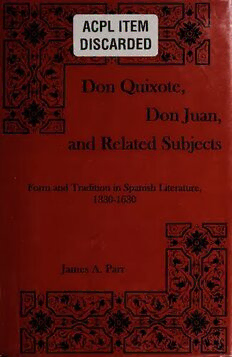
Don Quixote, Don Juan, and Related Subjects PDF
294 Pages·2004·18.143 MB·English
Most books are stored in the elastic cloud where traffic is expensive. For this reason, we have a limit on daily download.
Preview Don Quixote, Don Juan, and Related Subjects
Description:
This is a study of major figures, texts, and periods in Spanish literature prior to 1700. It applies - and interrogates - modern critical theory. Contributing to its cohesiveness are the time span addressed (1330-1630) and the emphasis throughout on literary tradition and critical approaches. It is inspired partly by Ramiro de Maeztu's 1926 monograph, Don Quixote, Don Juan y la Celestina, devoted to the three characters Maeztu felt to be the most important in the Spanish literary canon. include Celestina. The volume is divided into three parts. The first of these deals with Don Quixote, the second centers around the Don Juan figure created by Tirso de Molina, while the third ventures farther back in time to treat the major texts of the fourteenth, fifteenth, and sixteenth centuries, along with the problematic period concepts Renaissance and Baroque. James A. Parr is Professor of Spanish at the University of California, Riverside.
See more
The list of books you might like
Most books are stored in the elastic cloud where traffic is expensive. For this reason, we have a limit on daily download.
